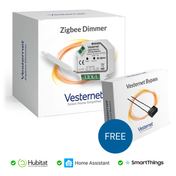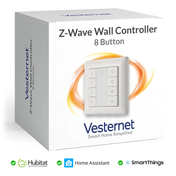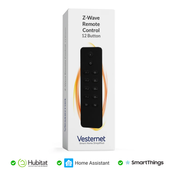Adding Z-Wave wireless control of your heating and hot water systems is easy to do.
This guide shows how to install the Secure Z-Wave Thermostat and Receivers in a typical home heating system.
Typical Heating and Hot Water System
 Figure 1: Simplified Heating and Hot Water system
Figure 1: Simplified Heating and Hot Water system
A simplified boiler-based heating and hot water system is shown in Figure 1. The components shown in blue help illustrate the whole system, they can be ignored for the purposes of this guide and when installing the Secure Z-Wave Receiver and Thermostat.
Universal Back Plate
Almost all heating/hot water systems have the main Timer/Controller installed on a Universal 6-pin Back Plate. This back plate has all the heating's wiring connected to it and enables users to easily change the timer/controller without being concerned about the systems actual wiring. Therefore, we can ignore all the wiring and other system components for this guide.
Junction Box
Most systems have a main junction box close to the timer and boiler. This has all the system's components wired directly to it (so they can easily be replaced in the future). You can ignore most of the wiring in the junction box, except for the existing wired thermostat.
Existing Thermostat
The system's existing wired thermostat is wired into the junction box. You will see from the wiring diagram that it is wired in series with the 'Heating On' power from the timer/controller. This means that no power is applied to the 'Heating Valve' unless the thermostat is closed (room temperature below its set point temperature). When we add the Z-Wave wireless thermostat, the existing wired thermostat can be removed from the system.
Installation for Heating Control Only
 Figure 2: Installing the Secure Thermostat and 1-Channel Receiver.
Figure 2: Installing the Secure Thermostat and 1-Channel Receiver.
To control just the heating you should install the Secure SSR303 1-Channel Receiver and Secure Wall Thermostat as shown in Figure 2:
- Turn Off the mains power to the heating system
- Remove the existing Timer/Controller from the Universal 6-pin Back Plate
- Install a suitable link wire between the 'L' and '2' terminals of the back plate - this is because the Secure 1-Channel receiver does not have an internal connection between 'L' and it's switch contacts (see internal wiring diagrams later in this guide).
- Install the Secure 1-Channel Receiver on to the back plate
- Turn On the mains power to the heating system
- Add the Thermostat and Receiver to the Z-Wave network using instructions in Application Note 20
Note: The receiver will not work correctly (even manually) without being added to the Z-Wave network - Set the wired thermostat to maximum - this ensures that it is closed
You can now control the heating from the Secure thermostat or from your Z-Wave controller.
The wired thermostat can be left in the circuit (set to maximum), or you can remove it from the circuit by removing the cables in the junction box and connecting a link cable as shown in Figure 3.
 Figure 3: Removing the existing wired thermostat.
Figure 3: Removing the existing wired thermostat.
Installation for Heating and Hot Water Control
To control the heating and hot water system you need to install the Secure SSR302 2-Channel Receiver and Secure Wall Thermostat (Figure 4).
Important Note:
The Secure manual (included with the product) is incorrect. The correct wiring for the SSR302 is shown in Figure 5 below.
Installation is almost identical to installing the 1-Channel receiver:
- Turn Off the mains power to the heating system
- Remove the existing Timer/Controller from the Universal 6-pin Back Plate
- Install the Secure 2-Channel Receiver on to the back plate
- Turn On the mains power to the heating system
- Add the Thermostat and Receiver to the Z-Wave network using instructions in Application Note 20
Note: The receiver will not work correctly (even manually) without being added to the Z-Wave network - Set the wired thermostat to maximum - this ensures that it is closed
- Remove the wired thermostat if you wish and install a link wire in the junction box
You can now control the heating from the Secure thermostat or from your Z-Wave controller.
 Figure 4: Installing the Secure Thermostat and 2-Channel Receiver
Figure 4: Installing the Secure Thermostat and 2-Channel Receiver
Secure Receiver Internal Wiring
These diagrams show how the Secure receivers are wired internally, including their switch contacts and terminals.
 Figure 5: Secure Receiver Internal Wiring and switch contacts
Figure 5: Secure Receiver Internal Wiring and switch contacts
Disclaimer:Installing the Secure Receiver involves working with 230V mains wiring. If you are not comfortable doing this you should consult a qualified electrician. This application note is provided as a guide, all work is carried out at your own risk. Vesternet do not accept any responsibility or liability. |
Fail Safe Mode
Both Secure Receivers include a Fail Safe mode that prevents the receiver staying ON if it loses contact with the Secure Thermostat. The receiver can only enter Fail Safe mode when the receiver's channel is On - it does not get activated when the channel is OFF.
In normal operation the Secure Thermostat sends a signal to the receiver's channel that it is associated with every 45-50 minutes. If the receiver channel does not receive this signal, the receiver will go into Fail Safe mode after 60 minutes.
If you are using the receiver without a thermostat, such as for hot water control, then you need to be aware of this Fail Safe mode.
For instance, if you turn on one of the receiver channels via a Scene, the receiver will enter Fail Safe mode after 60 minutes.
Therefore, for these types of scenes, you should have the scene set the receiver channel to 'On' every 30-45 minutes during its 'On' schedule period.
If you are using both channels without a thermostat, then you need the scene(s) to do the same for both channels as either one will cause the receiver to enter Fail Safe mode.
One way to do this is to use "Delays" in the scene - configure delays to repeatedly send 'on' throughout the duration of the scene's schedule.









